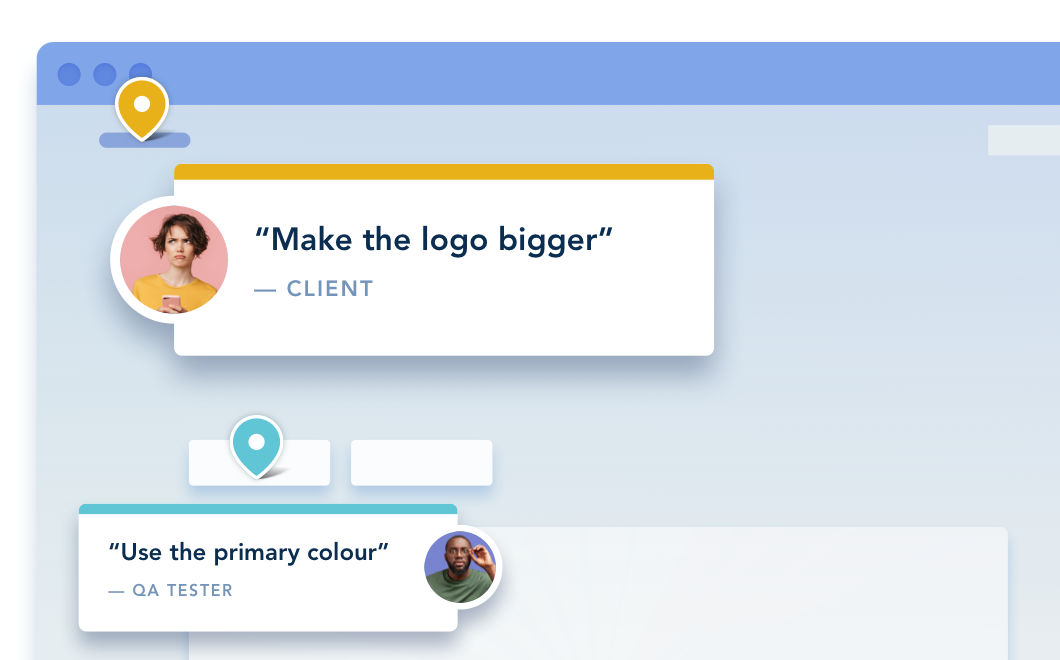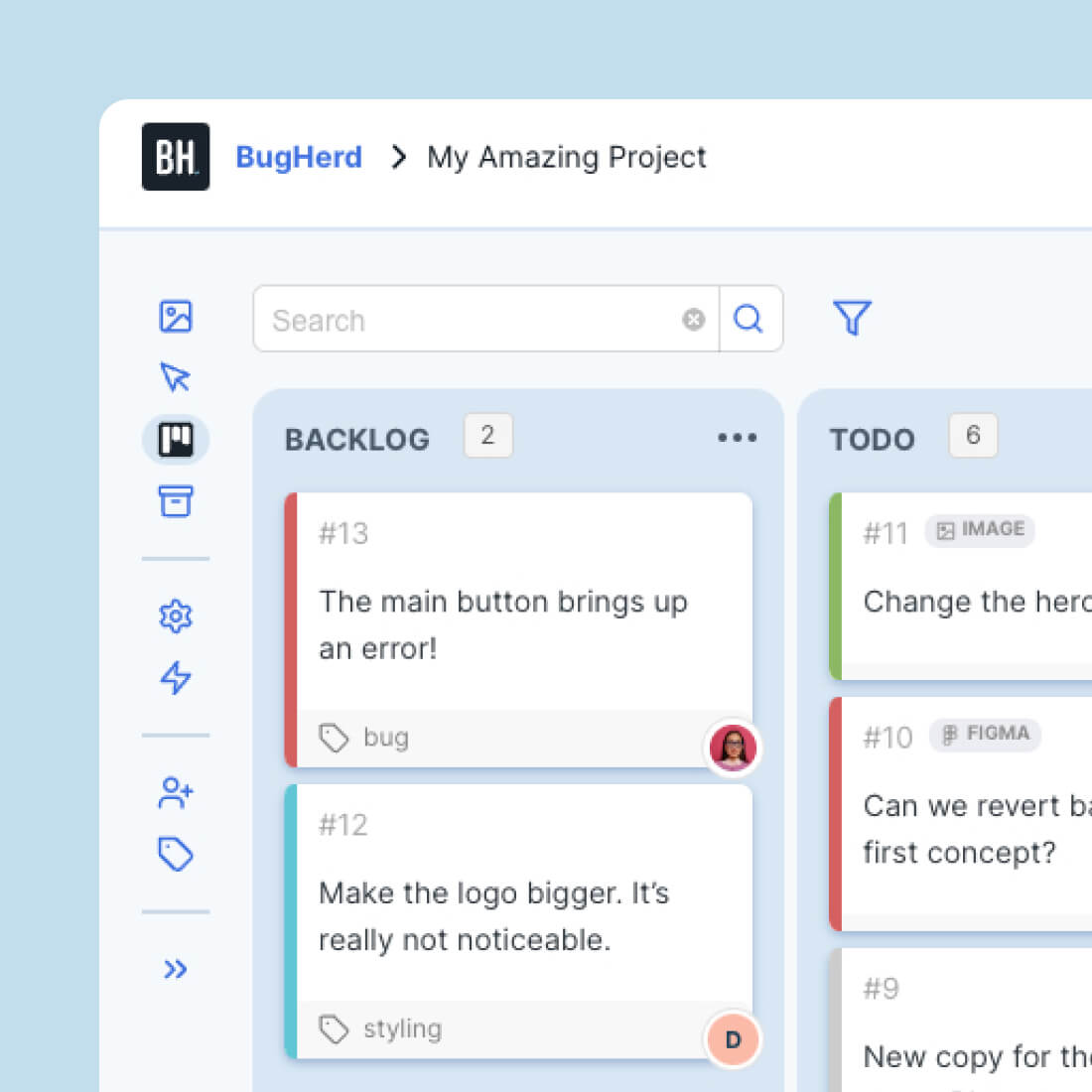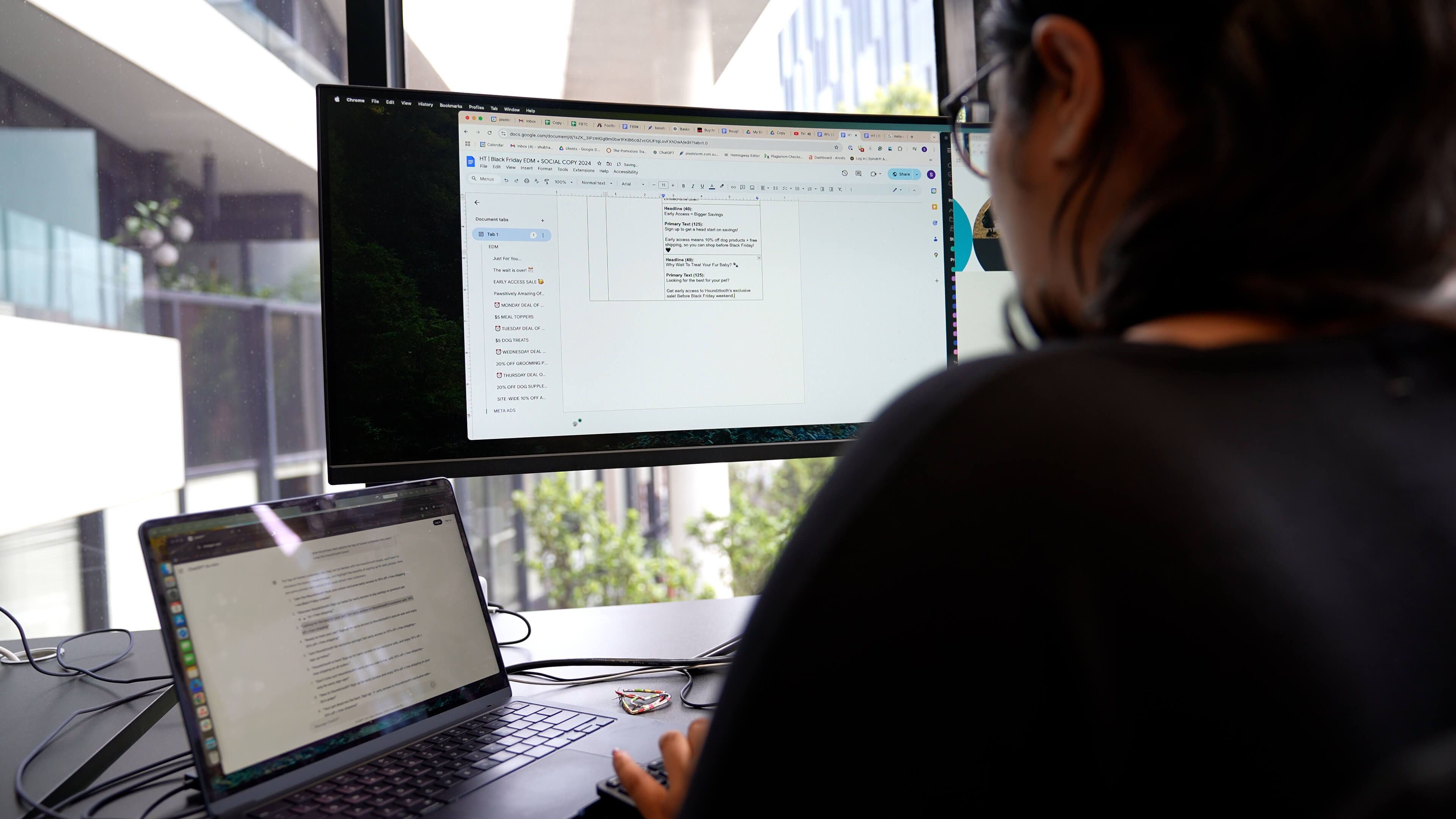What is a UI Workflow?
A UI (User Interface) workflow is a structured series of steps that guides designers, developers, and stakeholders through the process of designing, reviewing, and implementing user interfaces on websites, apps or software. It ensures that feedback, revisions, and approvals happen efficiently, minimizing delays and miscommunication.
Modern tools like BugHerd allow for in-context, visual feedback, turning chaotic review cycles into organized, actionable tasks.
Understanding UX Design Workflow Fundamentals
A UI/UX (user experience) workflow takes into account all the stages involved in the creation, testing, and deployment of user interfaces. It's designed to make sure that designers, developers, project managers, and stakeholders have a workflow in place that integrates real-time user feedback and continuous iteration, allowing them to adapt quickly to changes in requirements or stakeholder input. This adaptability helps to minimize miscommunication, accelerate delivery, and ensure the final interface meets both user satisfaction and business goals.
Effective user flows serve as a guidepost, combining structured tasks with flexible collaborative effort to produce polished, user-friendly digital products on time.
What are the Core Components of Effective UI Workflows?
Planning & Requirements Gathering:
This initial UX design process sets the foundation by defining the project goals, target users, business requirements, and team roles. Detailed planning helps align all stakeholders and clarifies scope, expectations, and deliverables.
Design & prototyping:
Design teams create wireframes, mockups, and interactive prototypes to visualize the interface’s layout, structure, and functionality as a part of the design process. This phase leverages visual design tools such as Figma or Adobe XD, focusing on usability and aesthetics within brand guidelines.
Feedback collection & review:
Gathering and reviewing feedback is crucial for refining visual designs. Visual feedback tools like BugHerd allow stakeholders to directly comment on UI elements with contextual data (browser, device, screen resolution) captured automatically, which can increase user engagement.
Iteration & refinement:
Based on feedback data collection, the UX design is revised to address usability issues, align with user needs, and fix visual or functional flaws. This phase may involve several revision cycles to perfect the interface.
Testing & validation:
Usability testing ensures the interface performs well in real-world scenarios. This includes market research, checking for accessibility, responsiveness, and consistency across devices, often involving end users in the validation process.
Deployment & monitoring:
After final approval, the UI design is handed off to the development team for implementation of the design system. Post-launch, teams monitor user flows, key elements, and collect ongoing research insights to inform future updates, ensuring sustained quality and performance.
Workflow vs Process
Workflow: A website design workflow is a specific sequence of tasks and activities carried out to complete a particular project or deliverable. It's flexible and adaptive to the needs of different projects, emphasizing collaboration, task delegation, and feedback integration tailored to the team and project at hand.
Process: A process refers to the broader, repeatable framework that governs how workflows are performed, often defined by organizational standards, policies, and best practices. Iterative processes ensure consistency, compliance, and quality across multiple projects or workflows by providing overarching guidelines and controls.
“A well-structured UX/UI workflow ensures that user experience and interface design are seamlessly integrated into the software development process.” - SevenCollab
How do you Build a UI Workflow?
1. Define clear objectives, project scope, and stakeholder requirements
Begin by establishing precise project goals, user journeys as per the target audience, user problems, research methods, and business requirements to guide UI UX design efforts. Engage stakeholders early to gather expectations and clarify success criteria from the very beginning. This alignment ensures everyone shares the same vision and prioritizes pain points, and work on features that deliver value.
2. Select appropriate design and feedback tools
Choose feedback tools that facilitate both design creation and seamless feedback integration from clients and team members. Design teams can use apps like Figma that enable collaborative prototyping, while tools like BugHerd empower stakeholders to provide contextual, visual feedback to the UX teams without technical barriers. Tool compatibility and ease of use are key considerations.

3. Define the project scope
Define project scope, communication channels, meeting cadences, and feedback cycles. Set clear expectations on response times, roles, and responsibilities to avoid confusion. Regular check-ins and a shared project calendar ensure accountability and transparent progress tracking.
4. Create initial prototypes, information architecture, and layouts
Product designers develop wireframes and interactive prototypes reflecting the agreed objectives and ideas. Early prototyping helps visualize workflows and functions, enabling quicker identification of gaps or improvements to the journey maps.
5. Use in-context visual feedback tools for review
Leverage visual feedback platforms like BugHerd for clients and team members to comment directly on UI/UX elements within prototypes or staging sites. This approach captures user technical details, streamlining communication and reducing misunderstandings with other departments (eg. URL, OS, browser, screen resolution, etc).
“Client comments arrived via spreadsheets, email threads, and screenshots, often missing context. With BugHerd, we reduced the time spent reconciling feedback by 75%, saved up to 10 hours each week, and accelerated client response times by up to 25%." — Bop Design

6. Track feedback and perform iterative refinements
Organize feedback into actionable tasks, prioritize issues, and assign responsibilities. Use an integrated task board with management features to monitor progress and ensure timely resolution. Repeat review cycles as necessary to refine the UI towards final approval.

7. Analyze feedback metrics and performance indicators
Collect and evaluate data on feedback volume, resolution speed, iteration count, and stakeholder satisfaction. Tools like BugHerd provide analytics that help identify bottlenecks and opportunities for process improvement.
8. Refine the design system based on lessons learned
Incorporate insights from performance analysis and team retrospectives to update workflows. Document best practices, successful strategies, and common pitfalls to create a knowledge base that guides future projects and promotes continuous improvement.
“Visual-feedback services are becoming ever more popular, and integrating one of them into [your] workflow would simplify the communication process of any web developer.” - SoftwareTestingMaterial
Which are the Best Tools for UI/UX Workflows?
For most teams, a solid UI/UX workflow stack looks like this: Figma for design + prototyping, Miro for discovery/flows and workshops, Balsamiq for fast low-fi wireframes, Maze for quick, remote user tests and analytics and BugHerd for visual, in-context website feedback during QA/UAT ... all connected to Jira/Asana/Trello (tasks) and Slack (comms).
This combo covers research → design → test → handoff → review without gaps.
Which are the Best Tools for Streamlined Feedback Collection in UI/UX Workflows?
Visual feedback tools like BugHerd are essential for modern UI/UX workflows, enabling precise, contextual feedback that accelerates design and development cycles. They enable stakeholders to click, comment, and annotate directly on web prototypes or live sites, providing precise context that speeds up revisions.
BugHerd stands out for its ease of use and powerful automation, capturing technical details such as browser, URL, screen resolution, and device type without any manual input. This metadata, combined with screenshots and annotations, gives developers clear, actionable insights, reducing miscommunication, decreasing the number of user interactions, and speeding up fix times.
The inbuilt Kanban task board makes it easy for teams to prioritize, manage and action feedback. BugHerd also has two-way integrations with leading tools such as Jira, Trello, ClickUp, Asana, GitHub, and many more, making it easy to fit into existing UI workflows.
Measuring UI Workflow Success
Key performance indicators of a UI workflow
Measuring the success of a UI workflow involves tracking specific key performance indicators (KPIs) that reflect both the efficiency and quality of the design and collaboration processes.
- Reduction in iteration cycles: This KPI measures the number of times a design element needs to be revised before receiving final approval. A decreased number of iteration cycles often signifies clearer communication, better initial alignment, and more effective feedback integration within the workflow.
- Time to final approval: The total duration from the initial design submission to the point of stakeholder sign-off. Shorter approval times generally indicate streamlined collaboration processes and fewer misunderstandings, reflecting an efficient UI workflow.
- Stakeholder satisfaction scores: Qualitative feedback gathered from clients, designers, and developers measuring how satisfied they are with the workflow, communication clarity, and the overall quality of delivered UI components. High satisfaction usually correlates with smoother collaboration and better project outcomes.
Metrics for speed and quality
Beyond these KPIs, monitoring metrics related to speed and quality ensures continuous improvement of UI workflows:
- Turnaround time: Measures how quickly feedback is received and acted upon after each review cycle, indicating responsiveness.
- Bug or issue resolution rate: Tracks the percentage of reported design or functionality issues resolved within a set timeframe.
- Iteration quality: Measured by the number of usability issues detected post-deployment versus pre-deployment, helping teams understand if earlier cycles were effective.
- Workflow transparency: The extent to which tasks and feedback are visible and traceable to all participants, reducing bottlenecks.
In Summary, a Great UI Workflow is This ...
A great UI workflow is the product of a clear, repeatable workflow that keeps content, design, engineering, and stakeholders in alignment. When your team defines scope up front, prototypes with intent, and captures feedback from clients and teams efficiently, projects move faster, quality goes up, margins stay intact, and you'll see increased user satisfaction.
If you run a digital agency, treat your UI workflow like a product: document it, measure it (iterations, time-to-sign-off, user satisfaction), and keep improving. Adopt tools that remove friction - Figma/Miro/Balsamiq/Maze for the discovery-to-testing stage, your favorite PM tool for workflow management, Slack or Teams for comms, and BugHerd for visual, in-context feedback during QA/UAT.
The playbook is simple: Set expectations, prototype early, collect feedback where the work lives, and close the loop with clear sign-off. That’s how you deliver better interfaces, happier clients, and maintain healthier profits without burning out your team.
Frequently Asked Questions
How long does it take to implement a UI workflow?
Implementing a UI workflow often takes between 4 to 8 weeks, based on project complexity and team size. This timeframe includes initial planning, defining objectives and roles, setting up collaboration platforms like BugHerd, and training team members. Early phases focus on adopting integrated visual feedback tools to facilitate clear, contextual communication.
What tools are essential for UI workflow optimization?
Key tools for effective UI workflow optimization include visual feedback platforms like BugHerd, which allows users to provide precise, contextual comments directly on UI elements with automatic capture of browser and device data. These tools transform fragmented feedback into organized, actionable tasks. Integration with project management software such as ClickUp, Jira, Trello, or Asana ensures smooth task tracking. Communication platforms like Slack or Microsoft Teams support real-time collaboration. Additionally, design and prototyping tools like Figma or Adobe XD that pair with feedback solutions enable seamless designer-to-developer handoffs.
How do you handle conflicting feedback in UI workflows?
Conflicting feedback is managed by prioritizing input based on project goals and user impact. Transparent tools like BugHerd enable visibility of all comments, helping teams identify overlaps and contradictions. Facilitated discussion sessions with key stakeholders resolve differing opinions effectively. Documenting decisions and rationale keeps everyone aligned.
Can UI workflows work with agile development?
Yes, UI workflows integrate well with agile development. Agile emphasizes iterative progress and continuous stakeholder involvement, which complements UI workflows focusing on rapid visual feedback and collaboration. Tools like BugHerd support sprint-based cycles by enabling quick feedback collection and resolution within short iterations. This synergy allows teams to refine UI components continuously and align closely with evolving user stories.
How do you measure UI workflow effectiveness?
Effectiveness is measured through both quantitative and qualitative metrics. Key indicators include feedback turnaround time, iteration counts, and bug resolution rates. Client and stakeholder satisfaction surveys provide valuable insights into communication effectiveness and ease of collaboration. Platforms like BugHerd offer analytics on task status, volume, and contributor activity, enabling teams to identify bottlenecks.
What's the difference between UI and UX workflows?
UI workflows focus primarily on creating, reviewing, and refining the visual and interactive elements of a product’s interface, and managing precise feedback related to these components. In contrast, UX workflows encompass a broader scope, including user research, usability testing, wireframing, and interaction design to optimize the full user experience. Both workflows are complementary but target different phases and aspects of product design.
How often should UI workflows be updated?
UI workflows should be revisited and updated regularly, ideally after each major project or sprint cycle, to incorporate lessons learned and address emerging challenges. Frequent updates help adapt to changing team dynamics, project scopes, technology advancements, and feedback tool improvements. Regular reviews encourage continuous process optimization, boosting efficiency and product quality.
What are the biggest UI workflow mistakes to avoid?
Common pitfalls include ignoring or under-involving stakeholders, leading to misaligned expectations; relying on fragmented communication channels like email or spreadsheets that create feedback silos; lack of visual context in feedback causing misinterpretation; poor task tracking and prioritization leading to unresolved issues; and neglecting regular workflow review and optimization. Avoiding these mistakes by using visual feedback platforms like BugHerd and establishing clear, collaborative, and iterative workflows ensures smoother UI development and higher-quality outcomes.












.png)




But don't just take our word for it.
BugHerd is loved by 10,000+ companies,
350,000+ users across 172 countries.
4.8/5
4.7/5
4.5/5
5/5
8.7/10
Sam Duncan 📱📏 🌱
@SamWPaquet
"@bugherd where have you been all my life??
We just migrated our bug tracking over from Asana and have at least halved our software testing time🪳👏📈. "
Ashley Groenveld
Project Manager
“I use BugHerd all day every day. It has sped up our implementation tenfold.”
Sasha Shevelev
Webcoda Co-founder
"Before Bugherd, clients would try to send screenshots with scribbles we couldn't decipher or dozens of emails with issues we were often unable to recreate."
Mark B
Developer
“A no-brainer purchase for any agency or development team.”
Kate L
Director of Operations
"Vital tool for our digital marketing agency.”
Paul Tegall
Delivery Manager
"Loving BugHerd! It's making collecting feedback from non-tech users so much easier."
Daniel Billingham
Senior Product Designer
“The ideal feedback and collaboration tool that supports the needs of clients, designers, project managers, and developers.”
Chris S
CEO & Creative Director
“Our clients LOVE it”
Emily VonSydow
Web Development Director
“BugHerd probably saves us
at least 3-4hrs per week.”